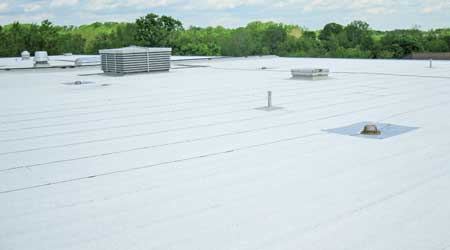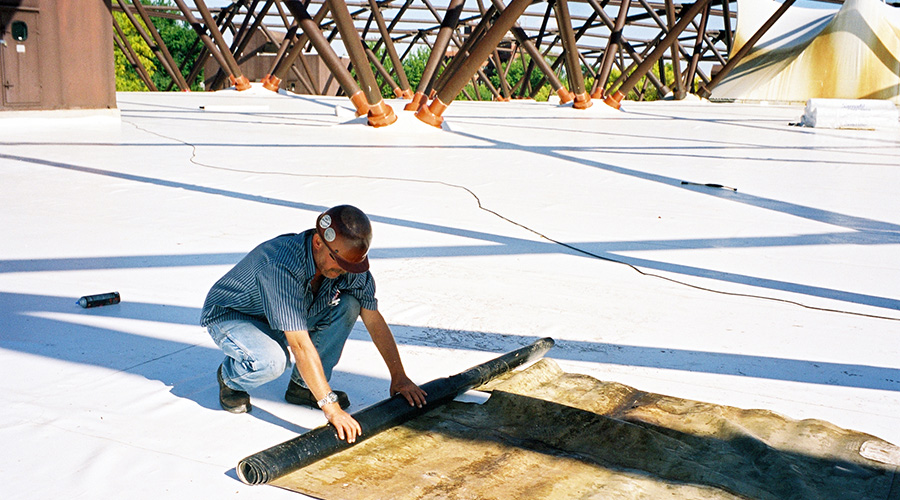 Cool roofing can save 10 to 15 percent on electricity costs by reducing air conditioning costs during peak demand when electricity is most expensive.Hoffman Architects
Cool roofing can save 10 to 15 percent on electricity costs by reducing air conditioning costs during peak demand when electricity is most expensive.Hoffman ArchitectsA Warming World Needs Cool Roofing
Yes, cool roofing helps save individual building owners money on cooling costs. But it also reduces urban heat islands and enhances community resilience.
The United States is getting warmer.
That’s not just speculation. That’s according to the U.S. Global Change Research Program (USGCR), a government initiative that “coordinates and integrates federal research on changes in the global environment and their implications for society.”
In 2017 the USGCR released a report stating with medium-to-very-high confidence that the United States has been experiencing rapid warming since 1979, with recent decades being the warmest in the last 1,500 years. The report predicts that this trend will continue late into this century, with an increase of 2.5 degrees Fahrenheit expected by 2050 and much larger increases expected by 2100. As a result, in the coming decades heatwaves are expected to become more frequent and intense.
One of the many consequences of this trend will be an increased demand for energy. And yet, as a result of our aging infrastructure, states are finding themselves with fewer traditional energy resources. New York, for instance, continues its decommissioning of Indian Point Nuclear Power Plant, just north of New York City, with full closure expected in 2021. This raises the question: how does New York State intend to replace the energy the plant created so they can meet increasing power demands?
As it turns out, they don’t - not entirely. New York has determined that its best option is not finding alternative sources of power, but following states like Massachusetts and Rhode Island in enacting programs to reduce energy use. New York isn’t alone in applying this calculus to energy policy, and the cumulative effect such decisions have on the built environment is significant.
The combination of rising temperatures and decreasing sources of energy have prompted increased focus on the efficiency and resilience of the built environment. Buildings consume 40 percent of our energy and 70 percent of our electricity while emitting one-third of the United States’ greenhouse gasses, according to the Alliance to Save Energy.
Efficiency continues to be captured and mandated by local building codes and legislation, like New York City’s Climate Mobilization Act, a recently enacted suite of laws intended to make the city carbon-neutral by 2050. But resilience, arguably as important and a necessary partner of efficiency, is often harder to quantify. What is resilience, and how does it help address issues like global warming and energy resource depletion? We can explore the subject by looking at the resilience of cool roofing.
What is resilience?
In general, resilience is the ability to resist or recover from difficulties. When we consider resilience in the built environment, we’re really talking about two things. “Asset resilience” refers to a building’s robustness, or, in this particular context, how well its design and construction can reduce operational costs, wear and tear due to thermal cycling, and impact on that asset’s surroundings. “Community resilience” is the corresponding ability of the local infrastructure and environment, such as power plants and the energy-supply grid, to resist stresses imposed by the collective assets. Community resilience can significantly reduce disruptions in the energy supply chain, curtail greenhouse gas emissions, slow climate change, and limit demands on available resources.
Asset and community resilience are often inversely proportional, with greater resilience of one reducing a corresponding burden on the other. For instance, a building that requires less energy to operate will reduce its impact on the local energy supply system, slightly reducing the level of resilience required by that system. When a large number of buildings are designed and constructed this way, the cumulative effect is a significant reduction in the demand on community infrastructure. The inclusion of cool roofing on a building can have such an impact on both asset and community resilience.
Related Topics:













